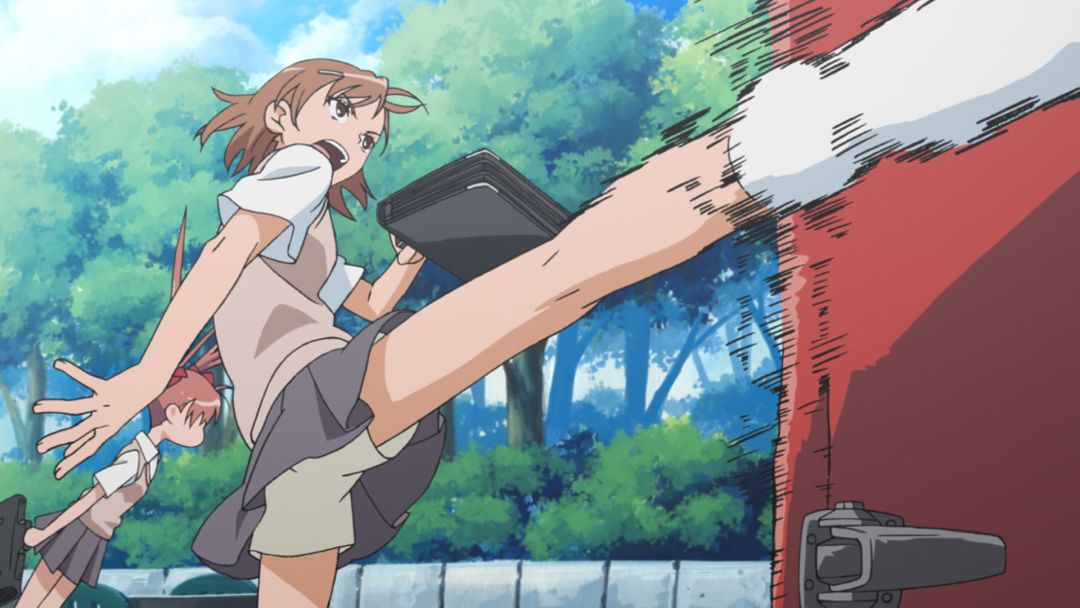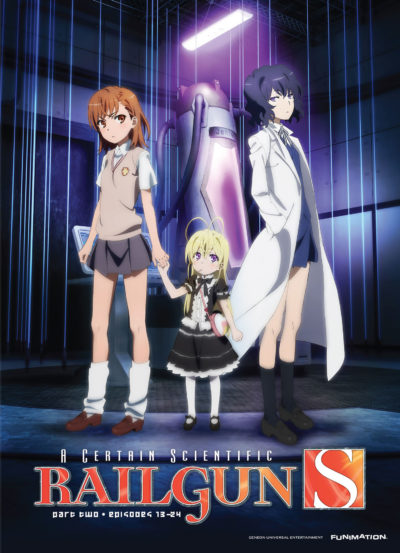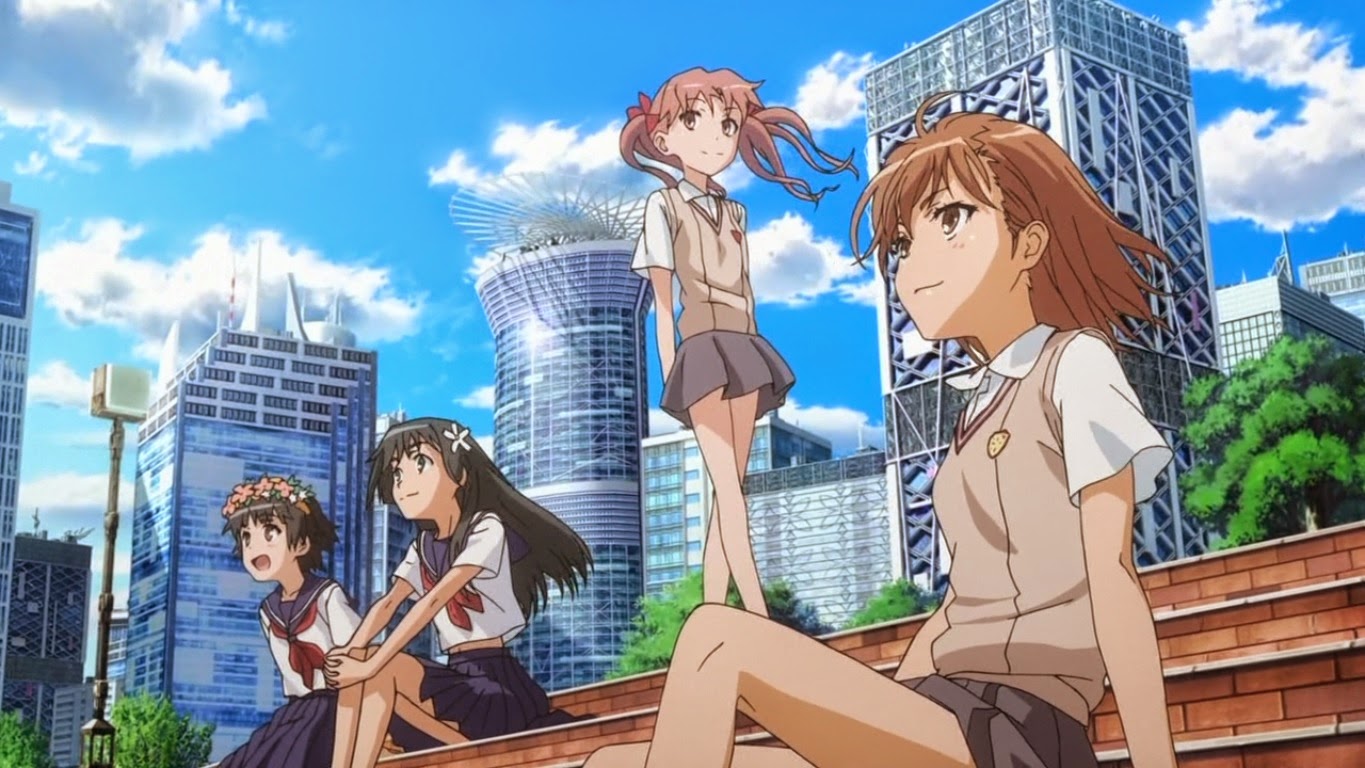 ★★★★
★★★★
“Bigger, stronger, faster, better!”
 Have you ever had this experience? There is a series you see and the series is fine, okay, solid. But without you noticing, you connect with these characters subconsciously, on an emotional level. As you watch them regularly, you get accustomed to them (though they are totally fictional) and don’t realize it until something happens, and you suddenly feel how much you have gotten attached to them. It’s not a new experience for me. It happens from time to time, but not often enough I would call it a rule, every time I watch a new TV show. Usually, I just passively experience the respective episodes and don’t waste much thought on it, least of all any kind of emotional investment.
Have you ever had this experience? There is a series you see and the series is fine, okay, solid. But without you noticing, you connect with these characters subconsciously, on an emotional level. As you watch them regularly, you get accustomed to them (though they are totally fictional) and don’t realize it until something happens, and you suddenly feel how much you have gotten attached to them. It’s not a new experience for me. It happens from time to time, but not often enough I would call it a rule, every time I watch a new TV show. Usually, I just passively experience the respective episodes and don’t waste much thought on it, least of all any kind of emotional investment.
It’s strange – at one point, when you started watching movies and series, you felt a strong emotional connection to everything, but today, it seems mostly gone. This does not only has to do with becoming a grown-up and seeing a lot more, but maybe also filmmakers and storytellers having forgotten the art of getting you emotionally involved in their plots and characters. But I have to say: A Certain Scientific Railgun got me, despite initially thinking I didn’t care much at all for the series. The show had been a satisfying, quite well told combination of “Slice of Life”-episodes, with some action-filled SF-arcs.
While for some. these “SoL” eps were unnecessary annoying filler episodes, I didn’t mind them. They provided additional colour to the big picture. I also was well aware I might not be the target audience: the Index series is the one supposed to be for the boys. Also, I went in without any specific expectations, always an advantage. Principally, I liked what I had seen, so had no problems with paying for another season. While sometimes things were maybe a bit too kawai for me, and the antics of a character like Kuroko Shirai could get on one’s nerves, the series was overall well thought-out, put attention into the details, and I enjoyed the emotional dispositions of the four girls, who all had their own character.
The next season arrived and… was even better?! Sure, it’s a subjective opinion, but I personally think the emotional investment I already had in the show paid off. The new season (from 2013, three years after the first was released) seemed to start like its predecessor: The girls going to school, spending time in their company, Kuroko abusing Mikoto… same old, same old, one might say. If one likes a season of a show, a new season is like meeting some good old friends again after a while. Then, the story starts to develop slowly… First in tiny steps that are hardly remarkable. There is a special art in storytelling when you are able to build up a story-line from small events to a big pay-off, when something finally can come to fruition and blossoms in a big climax.
People like Hitchcock, or some of the best action directors, know how to do that, but today I think it is virtually secret knowledge. I would certainly not have expected to find it in a Japanese anime, where you can be happy if one’s intelligence simply isn’t being insulted too much! It begins relatively harmlessly. Somebody claims to have seen Mikoto Misaka (our title-giving “scientific railgun”, thanks to her coin trick), but Mikoto wasn’t there at all. Then it happens again which leads to the girls talking about having a doppelganger, and eventually to the very interesting question, which forms the premise of this season: “What would you do, if you had a clone?”
 Another strange thing occurs. Somebody is leaving envelopes containing money in small, dark side-streets, leading to people going on their own treasure hunt, and Mikoto & Co. try to find out who’s doing that and why. The story constantly builds and you slowly realize that you are paying much more attention to the show then you ever did before. When Mikoto finally meets her doppleganger, it’s initially almost a shock. It leads to questions: who is the girl, why is she behaving so strangely, and where does she come from? Mikoto indeed has “sisters”. Actually, a lot of them. And these girls are part of an unethical and inhuman experiment.
Another strange thing occurs. Somebody is leaving envelopes containing money in small, dark side-streets, leading to people going on their own treasure hunt, and Mikoto & Co. try to find out who’s doing that and why. The story constantly builds and you slowly realize that you are paying much more attention to the show then you ever did before. When Mikoto finally meets her doppleganger, it’s initially almost a shock. It leads to questions: who is the girl, why is she behaving so strangely, and where does she come from? Mikoto indeed has “sisters”. Actually, a lot of them. And these girls are part of an unethical and inhuman experiment.
The series really managed to grab me here totally, and part of it is due to the way the story is constructed, something I mentioned when reviewing the previous season. We grow attached to Misaka over time, and care for what she is going through emotionally. I don’t know what I would do if I met my clone, but I guess I would be quite angry about somebody stealing my identity and misusing my genetic map, which is something Misaka also feels. But there is something unexpected happening. While the Misaka clones appear a bit strange and speak about themselves in the third person, they are instantly likable and cute, it’s shattering to find out what kind of role they have to play in an on-going “experiment”. It was quite a shock, at least for me who came along with no idea of the evil hiding in the shadows (I’m not spoiling that here!).
Again, much of the effect of the series lies in its careful combination. On the one hand, you have cute school-girls doing harmless girly stuff: studying, social services, sitting in cafés, mocking each other, searching together (as happens in one episode) for a four-clover-leaf in a green field. Then, suddenly, a hole of darkness opens where very evil people do very evil things, with hardly any remorse or justification for their acts. The contrast makes this story shocking: in another darker show, it would have been your typical, average stuff. Here, I almost got the feeling I’d watched an anime written by the Brothers Grimm! While we have seen much worse, it’s the combination of different elements that makes this work so well.
Unfortunately, our protagonist makes the decision to play Batgirl and solve the problem alone, without her friends, which I found a bit questionable. The climax of the previous season had shown how effective these four girls are when working together, and this can also be seen at the beginning of this season. But I guess as the so-called “sister-story-arc” was also already featured, albeit briefly, in A Certain Magical Index, the writers here were bound to how events played out in that series. It doesn’t look good for our little railgun: She experiences fear, despair, helplessness and pain. It’s quite some time since I saw so many relatable and believable emotions in an animated character.
It’s always nice when a powerful character is “cut down to size”: it adds realism to any story. Fantasy and SF stories should have rules and powers should have limits. And 5-level esper Mikoto, who in the past was not above bragging about her incredible electro-talents, experiences these, physically as well as emotionally. We look differently at our protagonists when they are not the strongest kid on the block anymore. Here, we meet megalomanical, sadistic villain Accelerator, who is more than a match for Mikoto. But then, Misaka is not totally alone; for there is still Touma Kamijou, the protagonist of A Certain Magical Index, the boy who wanted to protect Misaka previously and whom she challenged to a power-fight. Maybe he can help?
There are interesting aspects here. Do super-powers make you susceptible to arrogance, because you start subconsciously to feel superior to everyone else? It’s something the powerless Saten worried about in the first season before meeting Mikoto. The character of Kongou, a level 4-esper is like that (though she becomes more sympathetic this season), as is another level 5-esper introduced at the beginning of this series. You calso remember the many, many times when Mikoto used her powers carelessly in the past. To paraphrase Francis Bacon’s famous sentence: if power corrupts, do then superpowers corrupt…um, superly?
It’s a thought, albeit never directly articulated here, and is definitely evoked when watching this story. We also get a brief look into Accelerator’s past: he has a reason why he does what he does. Once again, the show manages to give us some understanding as to the villains’ motives. It delivers a much more layered approach than just telling us, as so many stories across so many media do: this guy is bad, and has to go! It makes the show more well-rounded, the stories much more satisfying, characters more ambivalent and therefore – if I may use the word – realistic. Also, kudos to the writers of these stories for applying the laws of physics in a logical, and well-considered manner!
 After this very well-built, suspenseful story arc, running from episode 2 until episode 16, I can understand why some felt the remainder of this season was a bit of a letdown. While we get another arc, the new one can’t quite compete with what happened before, though is decent on its own merits. For a while, we go back to small stories of the girls getting together and the usual jokes like e. Saten pulling up Uiharu’s skirt to embarrass her. Yes, that’s a thing. It’s alright by me. After you have clashed with the Big Bad, it’s absolutely fine to have another episode where your heroines are in a hurry to bring a cake to a meeting, where they drink tea and say goodbye to a friend who is moving away. It’s the “slice of life” aspect: if you are in for the meal, you have to eat the vegetables, too!
After this very well-built, suspenseful story arc, running from episode 2 until episode 16, I can understand why some felt the remainder of this season was a bit of a letdown. While we get another arc, the new one can’t quite compete with what happened before, though is decent on its own merits. For a while, we go back to small stories of the girls getting together and the usual jokes like e. Saten pulling up Uiharu’s skirt to embarrass her. Yes, that’s a thing. It’s alright by me. After you have clashed with the Big Bad, it’s absolutely fine to have another episode where your heroines are in a hurry to bring a cake to a meeting, where they drink tea and say goodbye to a friend who is moving away. It’s the “slice of life” aspect: if you are in for the meal, you have to eat the vegetables, too!
This season is not perfect; nor was the previous one. A possible flaw is it becomes almost a one-girl show with Mikoto on her own and her friends reduced to side characters e.g. Kuroko constantly worrying what is up with Mikoto and where her best friend spends her nights. Fortunately, this is corrected in the second story arc, dealing with Febri, a little girl who is the subject of an experiment herself. Mikoto finally learns she not only has good friends, but to take help when it’s offered. The power of friendship can even deal with very well-equipped forces of the dark and shady “underworld” in Academy City. These little lessons of morality integrated into the show, definitely leave a feel-good-feeling at the end.
Finally, we even learn about the motivations of some of the villains in the background. In a city where all those highly-enabled people are the focus of everyone’s attention, the “normal” people, regardless of how ingenious they may be or how hard they work, have hardly a chance of ever getting their spot in the limelight. Being constantly neglected can make you do very terrible things. But again: not everyone working on the side of the bad guys is necessarily an enemy and Mikoto gets her “Will Graham vs. Hannibal Lecter”-moment, so to speak! Once again the arc is well-built and develops the sensitive, emotional touches which make the show more than the usual action.
It ends in a very satisfying finale which sees almost everyone, including second-tier characters, join Mikoto’s final battle against the evil scientists’ group. There’s still a deadly satellite in orbit that could destroy Academy City unless Mikoto and Shirai get up there and blow it up in time. Shouldn’t be a problem for Mikoto, the city’s famous railgun, right? Watching this series felt for me a bit like seeing Kim Possible in an X-Files plot, spiced up with some great action from a Hollywood blockbuster. Though I could have done without the show’s main musical theme playing, once again, over the battle scenes during the finale. Here the producers really should have invested in some action music!
Some questions remain. What exactly will happen to the almost 10,000 “sisters” of Misaka? Are there other powers in the shadows we have not seen yet? Or is Academy City now free of big criminal-scientific organisations? Will Misaka get together with Touma? Probably not, since in his own series he has quite a harem of female followers. And what is with her obsession over that frog? Stay tuned, for J. C. Staff, the studio behind the show, also produced a third season, which came out a good seven years after this one. At least something good that came out of that terrible year! So, let’s continue…
Dir: Tatsuyuki Nagai and others
Star (voice): Rina Satō, Satomi Arai, Aki Toyosaki, Kanae Itō




